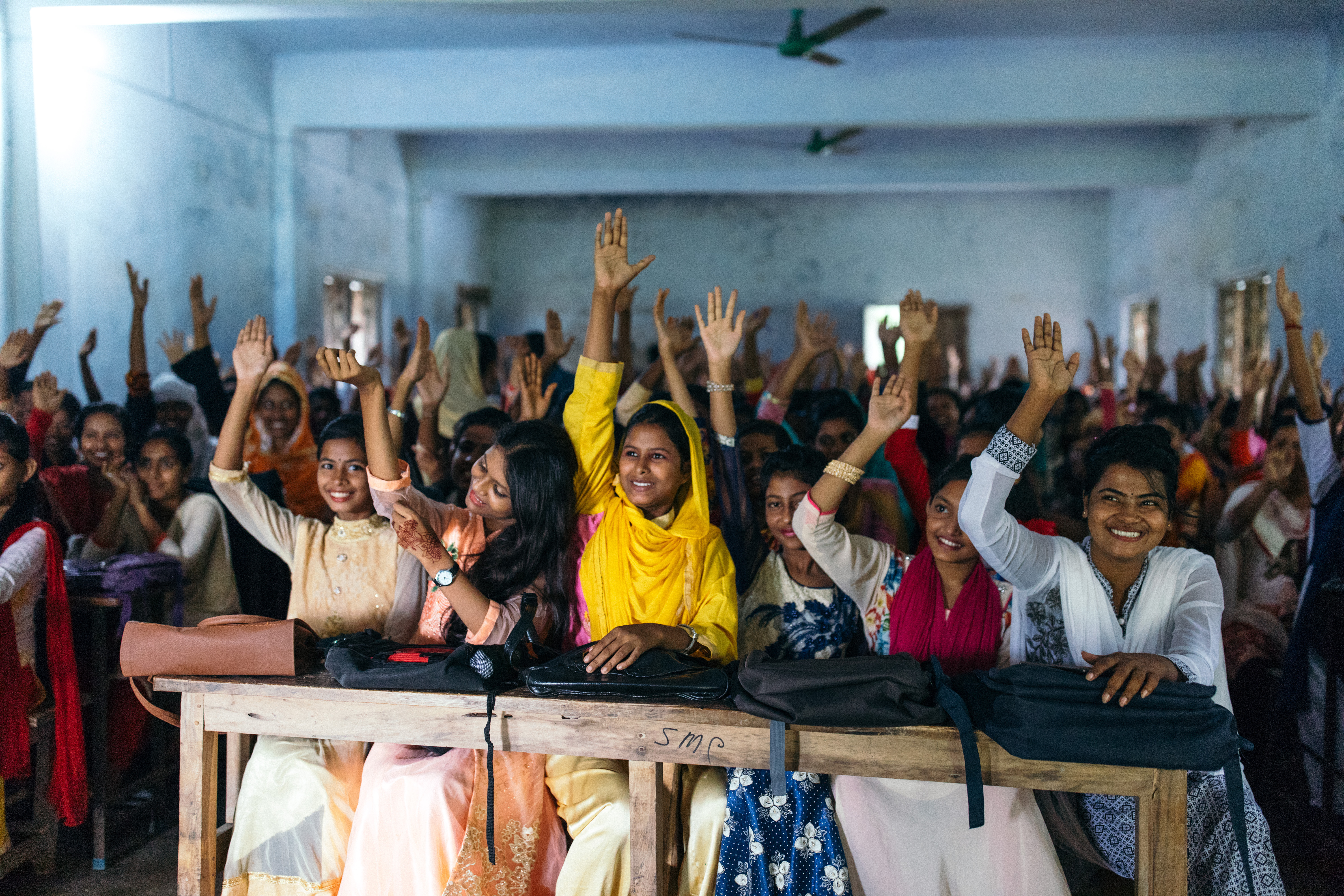
Mission
Speak Up for the Poor (SUP) exists to transform the world on behalf of the poor and create a new reality for girls in poverty.
Life Challenges of the Women Served
In Bangladesh, girls in poverty are considered second-class citizens, destined only for child marriage and domestic servitude. This means hundreds of thousands of girls across Bangladesh drop out of school early and are forced into illegal child marriages, some as early as age 13. These girls are often uneducated about sanitation and hygiene issues. They tend not to have positive teaching about their body and feminine health issues, and they tend not to have an adequate sense of safe behaviors to avoid exploitation and abuse.
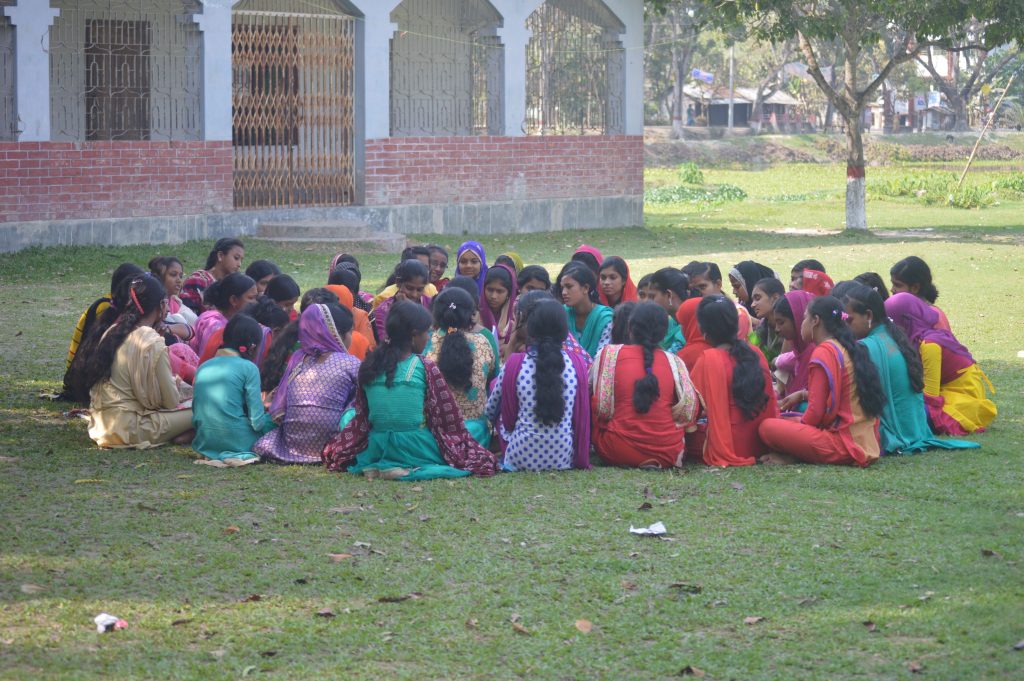 According to UNICEF, 59 percent of girls in Bangladesh are forced into illegal child marriages under the age of 18, and 22 percent are married before age 15 – the fourth highest rate of child marriage in the world.
According to UNICEF, 59 percent of girls in Bangladesh are forced into illegal child marriages under the age of 18, and 22 percent are married before age 15 – the fourth highest rate of child marriage in the world.
Girls who marry early face many obstacles and dangers. For every year a girl stays in school beyond the sixth grade, her future earning potential increases by 10 percent. Millions of girls are denied an education and are forever stuck without jobs or in menial, low-paying service jobs that further the cycle of female poverty. They are also vulnerable to being trafficked into prostitution. Brothels in Bangladesh are significantly populated by women who were married as children, divorced as young women, and forced into prostitution to feed their children. Girls who marry before age 15 are 50 percent more likely to suffer domestic abuse and violence from their husband. Child brides often do not understand their rights to bodily autonomy and safety, and globally nearly 50 percent of child brides believe that their husband has the right to abuse them.
Complications in pregnancy and childbirth are leading causes of death globally for girls ages 15 – 19. A child born to a mother under the age of 20 is 50 percent more likely to be stillborn or die in the first two weeks of life than other babies. There are also significant problems of STDs and AIDS transmission rates of girls who marry older men.
Many girls in SUP’s Girls Education Program (GEP) come from low-income families who lack formal education. Due to poverty, they have less access to soaps and cleaning products, do not have adequate feminine hygiene products, and have limited bathing and restroom facilities. They do not have adequate sex education or understanding of feminine hygiene, and often have to deal with feminine health issues in sub-standard ways. Many girls have skin problems arising from unclean home environments, and have unclean drinking water and related health issues, such as diarrhea and other diseases arising from poverty.
The Project
The goal of this project is to provide girls and women in SUP’s Girls Education Program with the information and resources they need for optimal health, safety, and well-being. The primary activity of this project will be 36 grade-specific training meetings for girls held over the course of the year. Girls in the sixth grade will have six training meetings; girls in grades 7 – 12 will have five training meetings. Each of these meetings will have from 100 to 200 girls from 30 different villages, all meeting together by grade to deal with a series of safety and health topics.
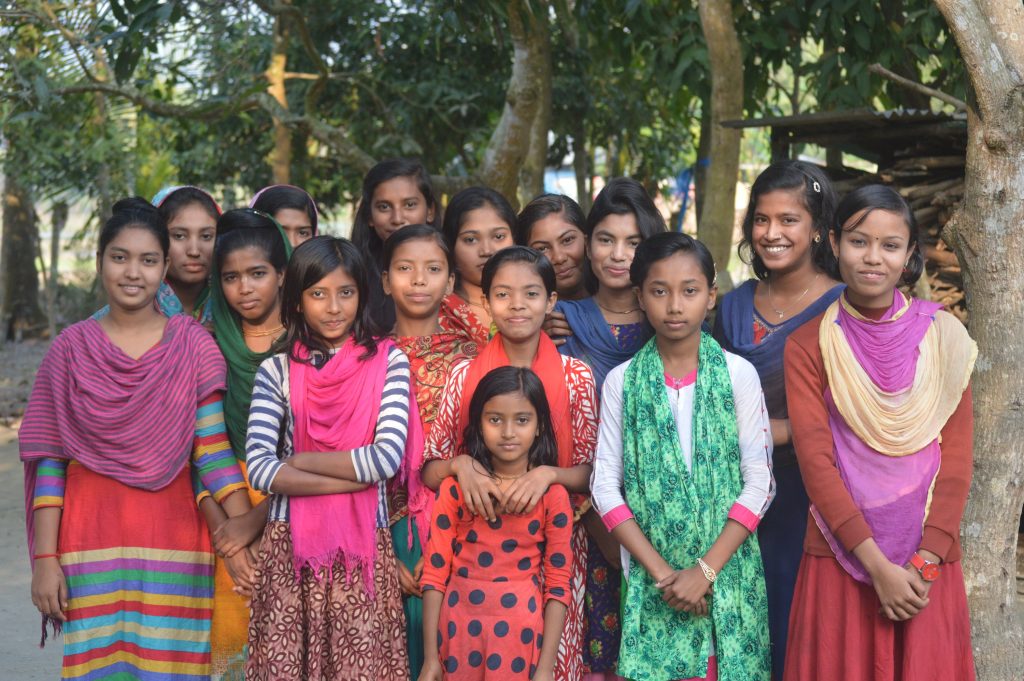 The project is open to all girls from grades 6 – 12 who are enrolled in SUP’s Girls Education Program. Any girl who lives in the 30 villages where SUP works is eligible to join the GEP. All she needs to do is register, get permission from her parents, sign some paperwork, and regularly attend school and SUP’s tutoring sessions. There is strong interest in all 30 villages and a large waiting list to join the GEP. Girls eagerly await the opportunity to join.
The project is open to all girls from grades 6 – 12 who are enrolled in SUP’s Girls Education Program. Any girl who lives in the 30 villages where SUP works is eligible to join the GEP. All she needs to do is register, get permission from her parents, sign some paperwork, and regularly attend school and SUP’s tutoring sessions. There is strong interest in all 30 villages and a large waiting list to join the GEP. Girls eagerly await the opportunity to join.
SUP works closely with the parents and guardians of each girl in the GEP program to ensure that they support their daughter’s education and goals. This support is encouraged in a number of ways, including involving parents in a monthly meeting in each village, and providing a series of training seminars and meetings with local officials to ensure both that parents’ voices are being heard and that they understand the importance of backing their daughters in this project.
By the end of the project, girls will understand the following issues:
- – The necessity of regular handwashing, and practicing this before and after every meal and at least several other times every day.
- – Age-appropriate feminine hygiene issues: what products to buy and use, who to talk to about these issues, resulting in a reduced stigma or embarrassment of their body.
- – The basics about infections and skin diseases: the sources of these problems, how to identify the early onset of these issues before they become a bigger problem, how to access health care for simple problems, and how to have the confidence to speak up about skin disease and other illness issues.
- – The basics of clean water for bathing and cooking and how to teach/influence their family to pursue better water hygiene.
- – Rights to bodily autonomy and decisions about their body and life, including their right to decide if and when they will marry.
- – Laws about child abuse, child marriage, sexual abuse, domestic abuse, and spousal rape, and who to talk to about these issues and how to access help if they ever have problems.
Girls will be further empowered to use the SUP Youth Clubs in 30 villages to address specific problems such as the need for better wells or restroom facilities. They will grow in self-confidence and determination to reach their goals as they realize they are not destined to live under prior systems of poverty and abuse. They will have many chances to lead meetings, practice public speaking, and talk about their rights and desires and goals, empowering them to have more ownership and control of their own lives.
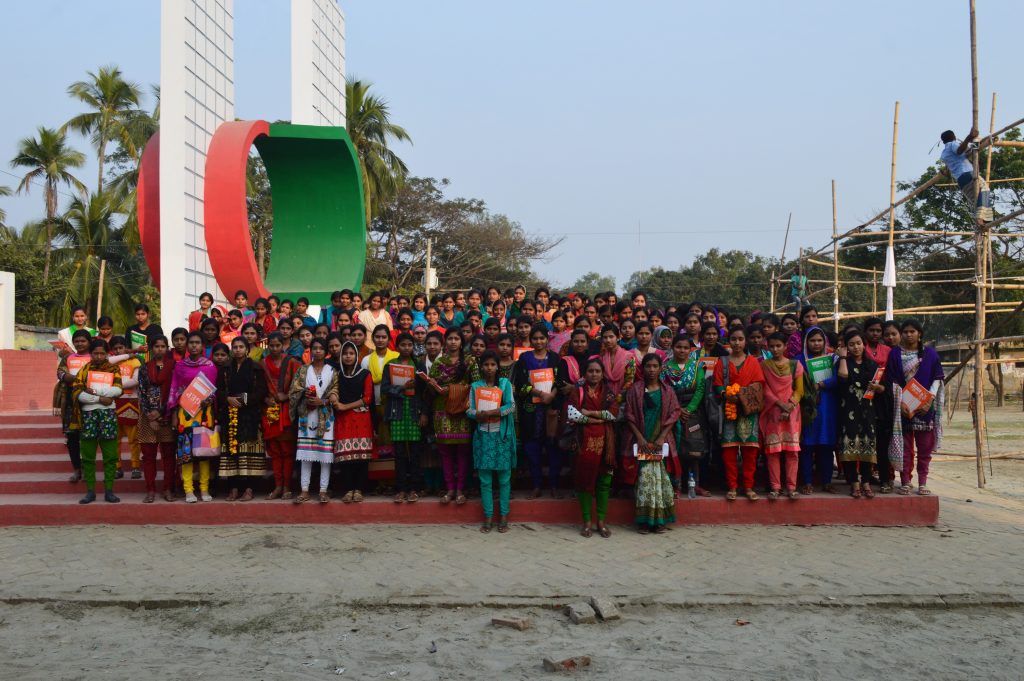 The project will serve at least 1,315 girls in grades 6 – 12 who participate in SUP’s Girls Education Program. An additional 350 girls from the GEP waiting list will experience some trainings at SUP’s village Learning Centers. A minimum of 1,665 people will be directly impacted by the program, all of whom are women and girls.
The project will serve at least 1,315 girls in grades 6 – 12 who participate in SUP’s Girls Education Program. An additional 350 girls from the GEP waiting list will experience some trainings at SUP’s village Learning Centers. A minimum of 1,665 people will be directly impacted by the program, all of whom are women and girls.
Family members of the girls in the GEP will by indirectly impacted by the project as GEP members share what they learn with them. At least 4,995 family members of girls in the GEP and on the waiting list (a minimum average of three family members per girl, x 1,665) will be indirectly affected, half of whom are women and girls (at least 2,497 women and girls indirectly affected).
Along with the female GEP staff, young women from the community who have participated in the GEP and are now in nursing school, or have completed nursing school, will advise, lead, and teach health-related sessions in the Girls Health and Safety Program.
Impact:
Direct: 1,665; Indirect: 4,995, including 2,497 women and girls
UN Sustainable Development Goals
![]()
![]()
![]()
![]()
![]()
Questions for Discussion
- What impact does this project have on gender equality?
- How important is parental buy-in?
- How do you think the age-specific training of this project will affect its success?
How the Grant Will be Used
DFW’s grant of $26,189 will cover costs associated with 36 health and safety training meetings for a minimum of 1,665 girls and young women in SUP’s Girls Education Program in Bangladesh.
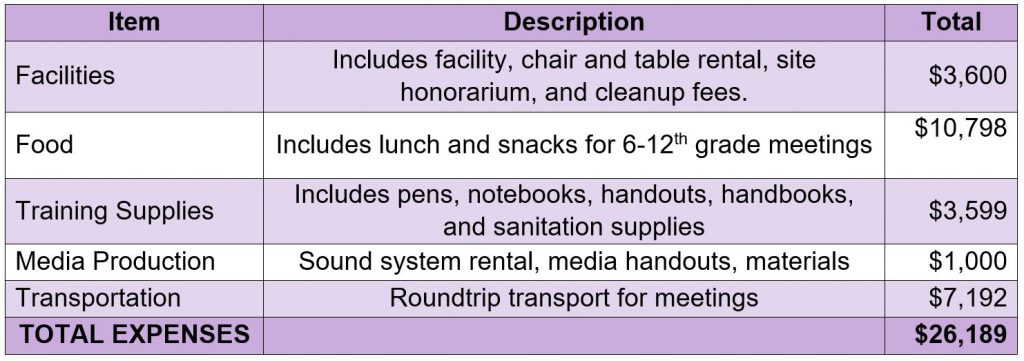
Why We Love This Project/Organization
Speak Up for the Poor has an excellent track record of keeping girls in school in low-income communities of Bangladesh, where the rate of child marriage is as high as 80 percent. This project offers age-appropriate teaching and training on optimal health, safety, well-being, and the importance of staying in school. Girls also learn about body autonomy and existing laws surrounding child abuse, child marriage, sexual abuse, domestic abuse, and spousal rape. This is a new reality for girls and women built on affirmation of their value, worth, and importance to their families and societies, and it allows them to flourish and thrive.
Evidence of Success
Ove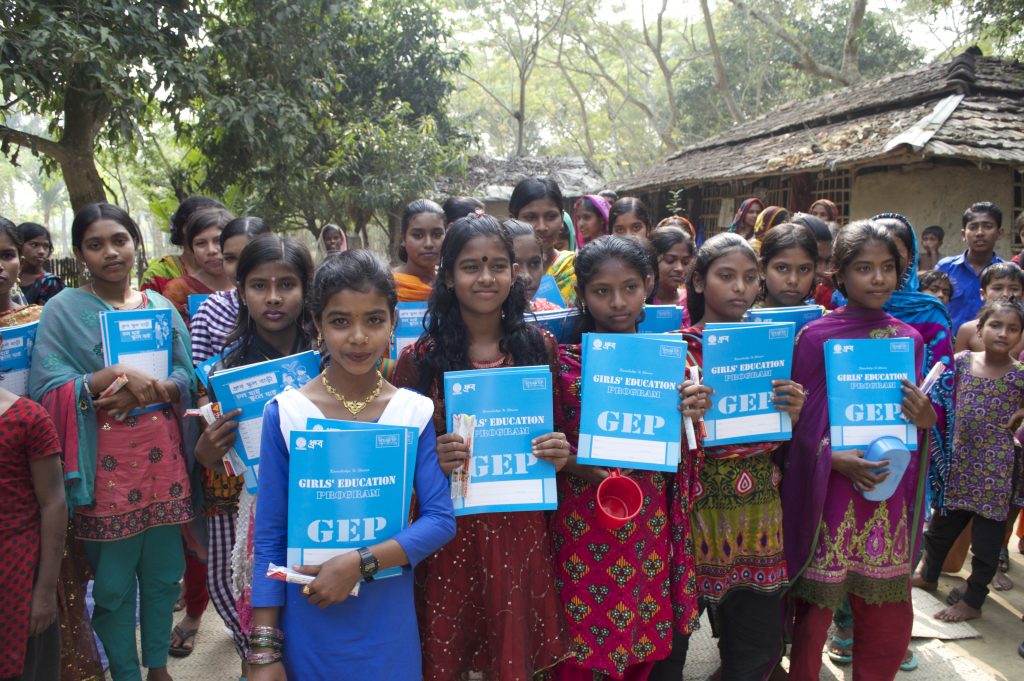 r eight years, SUP’s Girls Education Program (GEP) has had nearly a 95 percent retention rate every year, meaning that only a very small percentage of their GEP girls are dropping out of school to get married. For example, for years SUP had seen girls as young as 13 get married in Kashipur, and in the poorest areas there were no girls in high school. After starting the GEP in Kashipur in 2014, SUP now has more than 75 young women in high school and college in Kashipur.
r eight years, SUP’s Girls Education Program (GEP) has had nearly a 95 percent retention rate every year, meaning that only a very small percentage of their GEP girls are dropping out of school to get married. For example, for years SUP had seen girls as young as 13 get married in Kashipur, and in the poorest areas there were no girls in high school. After starting the GEP in Kashipur in 2014, SUP now has more than 75 young women in high school and college in Kashipur.
Fourteen young women who have participated in SUP’s GEP since 2012 have already graduated from college or nursing school, the first from their families and villages to complete a higher education. Of the 1,440 young women from sixth grade through college currently enrolled in the GEP, 221 of them are now in 12th grade, or taking their post-12th grade High School Certificate exam in 2020, and another 121 are currently enrolled in college or other higher education. Nearly all of these young women would have been married in childhood, or already dropped out of school prior to 12th grade without SUP’s intervention.
Speak Up for the Poor actively recruits girls from the GEP to be on the SUP staff once they finish college, so girls know that there is a path into leadership of the organization. Many of their current part-time teachers are young women who have finished high school through the GEP, and several of them are on the path to grow into mid-level positions in the coming year. Currently, 25 young women in the GEP are in a degree program or nursing school, working toward becoming nurses. SUP foresees that within three years or less, some of these nursing graduates could work together with the local communities in which the GEP currently operates to sustain a project like this on their own.
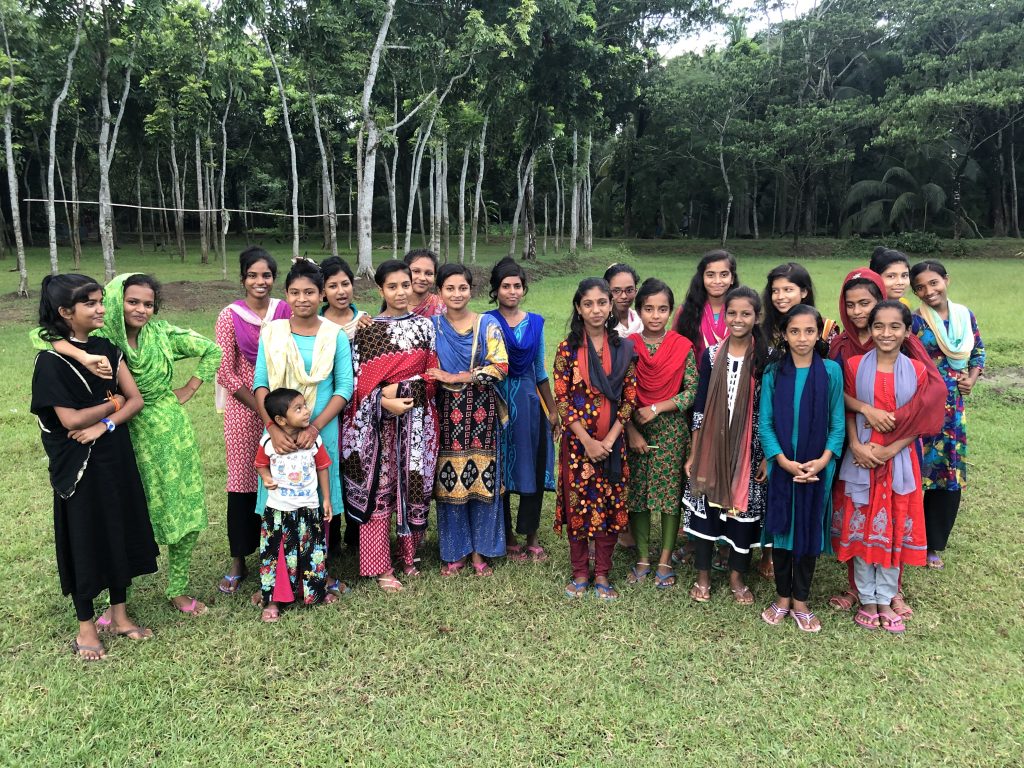 While it is difficult to calculate a change in marriage rate among a sample of more than 1,447 girls from a broad age-spectrum, ages 10 – 21, SUP has been able to significantly reduce child marriage in most of the villages where they work. At least 400 out of 1,447 girls in the GEP would likely be married if not for involvement in GEP.
While it is difficult to calculate a change in marriage rate among a sample of more than 1,447 girls from a broad age-spectrum, ages 10 – 21, SUP has been able to significantly reduce child marriage in most of the villages where they work. At least 400 out of 1,447 girls in the GEP would likely be married if not for involvement in GEP.
Today, SUP has more than 120 young women living in Khulna city or other cities around Dhaka pursuing college studies, a number which includes 13 in nursing school. These young women all come from villages where previously virtually no women ever went to college.
Voices of the Girls
“I am now an Honors 3rd year student. I have been studying through the GEP for five years. My village is called Raghunathpur. Girls in our society get married at a very young age. People in our society think that a 12- to 15-year-old girl is ready to get married, and boys have a demand for girls of this age. But I don’t think it’s right to marry girls before the age of 18. Now that I am growing up through education and committed to fulfilling my 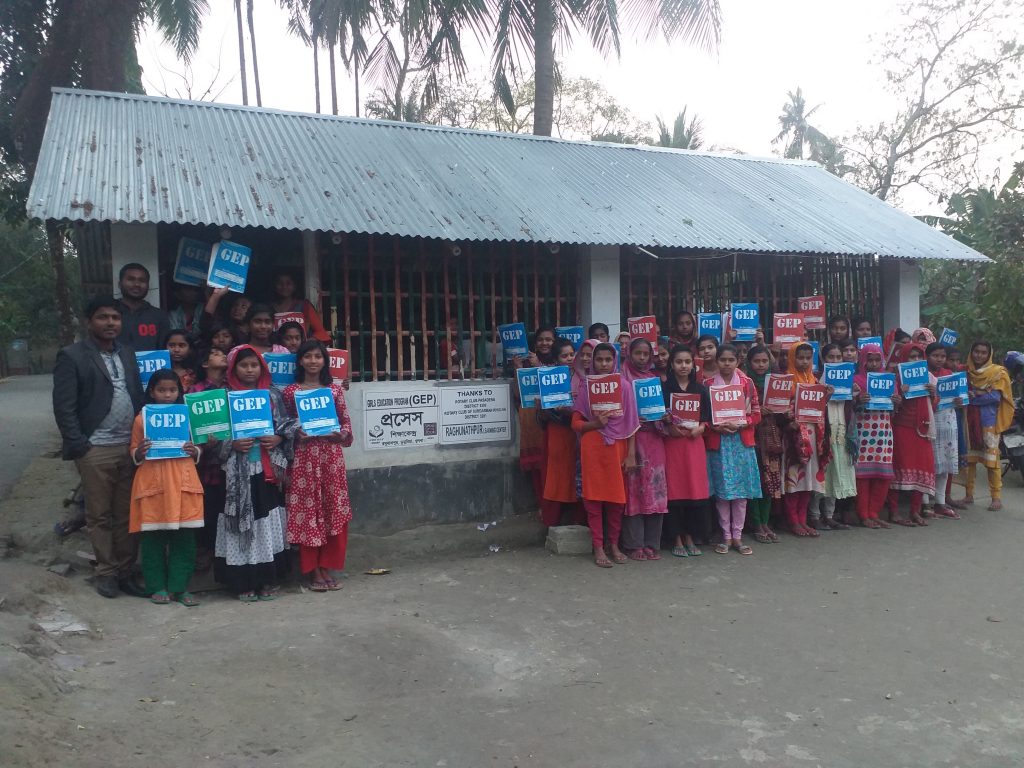 dreams, I hope that every girl in Bangladesh will continue her education and build a beautiful future for herself. The GEP has created our learning opportunities and is imparting practical knowledge through various trainings. We are grateful for that. Also 1,600 girls from 30 villages in Khulna area like me are growing up to fulfill their respective dreams through education in collaboration with GEP. We would like to thank and appreciate the Dining for Women group that we are going to receive health and safety training in the future. Through this training we will gain more knowledge on the subject and become stronger to save our own lives. Thank you.”
dreams, I hope that every girl in Bangladesh will continue her education and build a beautiful future for herself. The GEP has created our learning opportunities and is imparting practical knowledge through various trainings. We are grateful for that. Also 1,600 girls from 30 villages in Khulna area like me are growing up to fulfill their respective dreams through education in collaboration with GEP. We would like to thank and appreciate the Dining for Women group that we are going to receive health and safety training in the future. Through this training we will gain more knowledge on the subject and become stronger to save our own lives. Thank you.”
- Luxmi
“My house is in Khornia village. If the GEP had not been there for me, I would have been married by now. Maybe I would have accepted child marriage and would now be living with my husband and children. But I am lucky to be able to continue my studies through this program. I get all the support from this program including my housing and food. I dream now that I will be a doctor one day. And as a doctor, I will serve the poor people and help helpless girls like me to study and fulfill their dreams. I am grateful that I am getting support through GEP and growing in the mindset of collaborating with others. I believe I will reach my goal one day. I thank and appreciate the Creator for everything.”
- Dipa
About the Organization
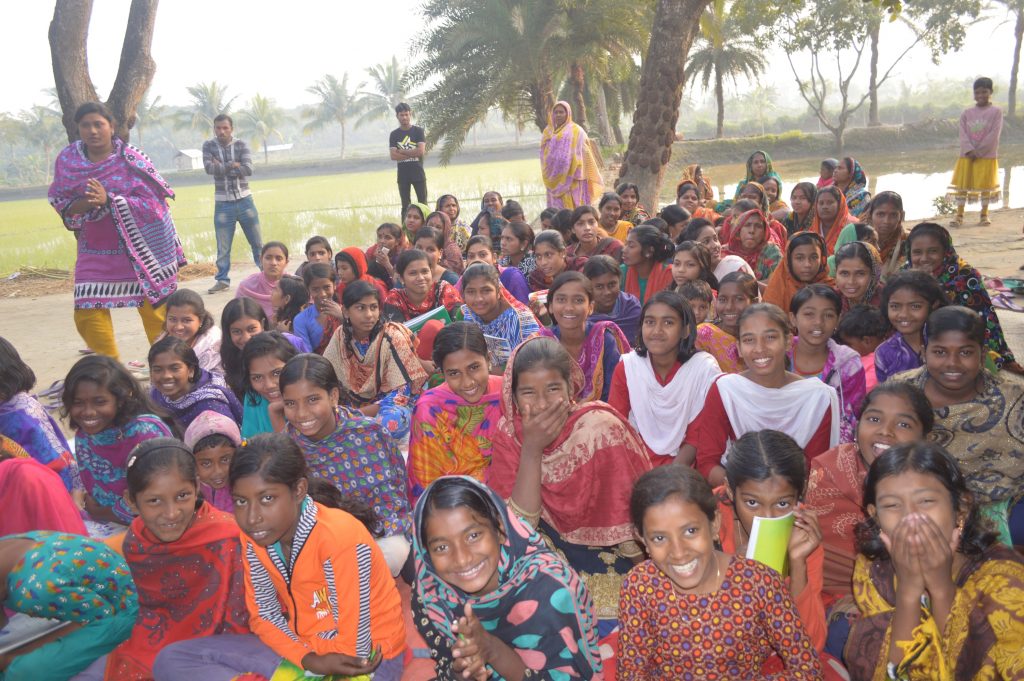 Speak Up for the Poor was established in February 2004 by Troy Anderson. Since 2013, he has lived and worked in Thailand and Bangladesh. SUP officially began operations in Bangkok, Thailand in 2008. In 2012, SUP initiated the Girls Education Program in Khulna Division, Bangladesh. GEP has grown from 20 girls in three villages in 2012 to 1,440 girls in 30 villages today.
Speak Up for the Poor was established in February 2004 by Troy Anderson. Since 2013, he has lived and worked in Thailand and Bangladesh. SUP officially began operations in Bangkok, Thailand in 2008. In 2012, SUP initiated the Girls Education Program in Khulna Division, Bangladesh. GEP has grown from 20 girls in three villages in 2012 to 1,440 girls in 30 villages today.
SUP’s primary service is the Girls Education Program in Khulna Division, Bangladesh. It provides after-school tutoring, school uniforms, books and materials, and school and exam fees to 1,440 girls from impoverished backgrounds who otherwise would be hindered from staying in school because of poverty and the high prevalence of child marriage, which almost always ends a girl’s education. SUP provides monthly community meetings in the 30 villages in which they work to educate thousands of adults and children regarding the importance of education for girls and the detrimental consequences of child marriage. SUP also provides regular grade-level meetings for GEP girls to provide inspiration to continue in school, training in life skills and professional skills, and it operates a girls’ dormitory for 90 girls and young women who need a safe living environment to attend school or college in Khulna city.
Where They Work
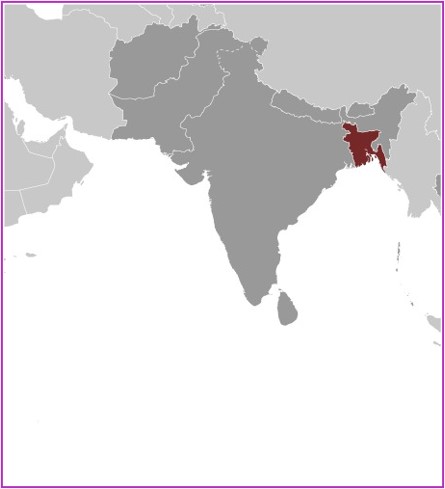
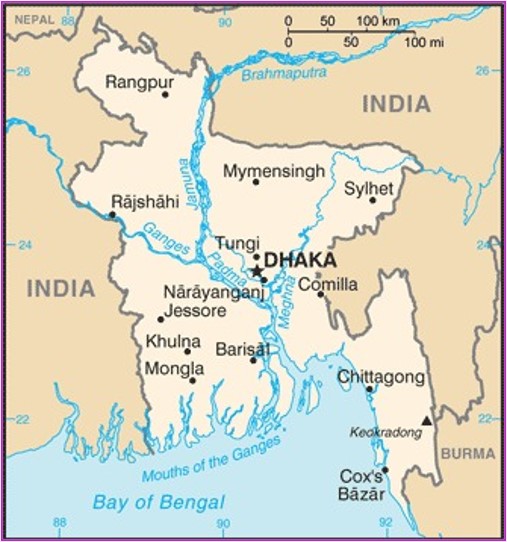
Bangladesh is located in Southern Asia, bordering the Bay of Bengal, between Myanmar and India. Its population is 162,650,853 (July 2020 est.). Its climate is tropical, with monsoons from June to October.
Bangladesh’s economy has grown roughly 6 percent per year since 2005 despite prolonged periods of political instability, poor infrastructure, endemic corruption, insufficient power supplies, and slow implementation of economic reforms. Although more than half of GDP is generated through the services sector, almost half of Bangladeshis are employed in the agriculture sector, with rice as the single most important product.
Seventy percent of the land is agricultural. Many people are landless and forced to live on and cultivate flood-prone land. Waterborne diseases are prevalent in surface water. Water pollution, especially of fishing areas, results from the use of commercial pesticides, and ground water is contaminated by naturally occurring arsenic. There are intermittent water shortages because of falling water tables in the northern and central parts of the country. Other issues include soil degradation and erosion, deforestation, destruction of wetlands, and severe overpopulation with noise pollution.
Garments, the backbone of Bangladesh’s industrial sector, accounted for more than 80 percent of total exports in FY 2016-17. The industrial sector continues to grow, despite the need for improvements in factory safety conditions.
The median age in Bangladesh is 27.9 years and life expectancy is 74.2 years. The mean age of mothers at first birth is 18.5 years (2014 est.). The maternal mortality rate is 173 deaths/100,000 live births. The infant mortality rate is 28.3 deaths/1,000 live births.
The risk of major infectious diseases is high. Most prevalent are food or waterborne diseases. Dengue fever and malaria are high risks in some locations, as is rabies.
The literacy rate is 73.9 percent, with 76.7 percent of males being literate, and 71.2 percent of women being literate.
A Closer Look at Economic Security and Child Marriage
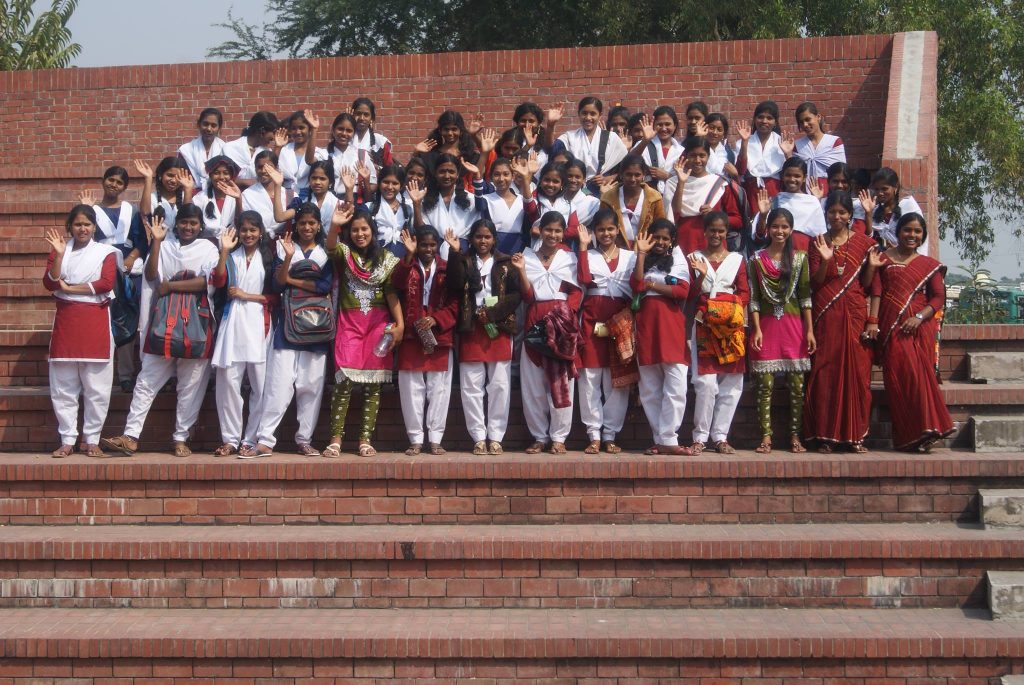 The World Bank and International Center for Research on Women carried out a three-year research project which concluded that ending the practice of child marriage could save the global economy trillions of dollars by 2030. Child marriage is estimated to cost economies at least 1.7 percent of their GDP. By not marrying early and staying in school, a girl is more likely to be healthier and wealthier, and reinvest her income into her family.
The World Bank and International Center for Research on Women carried out a three-year research project which concluded that ending the practice of child marriage could save the global economy trillions of dollars by 2030. Child marriage is estimated to cost economies at least 1.7 percent of their GDP. By not marrying early and staying in school, a girl is more likely to be healthier and wealthier, and reinvest her income into her family.
However, in the reality of places where poverty is acute, daughters are frequently seen as burdens or commodities because of pervasive gender inequality. Impoverished parents often believe marriage will secure a daughter’s future by making a husband or his family responsible for her care. Giving a daughter in marriage allows parents to reduce family expenses by ensuring they have one less person to feed, clothe, and educate. In some cases, marriage of a daughter is a way to repay debts, manage disputes, or settle social, economic, and political alliances. The economic security that child marriage offers families can be a driving factor in its continuation as a practice.
Child marriage can increase during humanitarian crises, such as in conflict or after a natural disaster, or during an epidemic. When families face even greater hardship, they may see child marriage as a coping mechanism in the face of poverty.
For example, the high incidence of child marriage in conflict-ridden Afghanistan is directly tied to poverty and low levels of development. Sixteen percent of children are married before the age of 15; 52 percent are married before 18.
COVID-19 has also become a factor in child marriage. As economies shut down and stay-at-home orders become the new normal, a damaging effect of the pandemic is a global spike in child marriages. In fact, the COVID-19 pandemic is estimated to result in 13 million more girls being forced into early marriages between 2020 and 2030.
The COVID health crisis has exacerbated some of the main social and economic drivers of early marriage, such as limited access to education, early pregnancies, and poverty. Pandemic-related school closures have interrupted the education of approximately 1.6 billion children worldwide. Also, one million more girls risk becoming pregnant due to the lockdown measures and disrupted access to reproductive health centers and services given the abrupt halt of interventions by governments, civil society, and/or NGOs. To avoid the stigma associated with out of wedlock pregnancies, families may be more inclined give their daughters in marriage.
Source Materials
International Center for Research on Women
